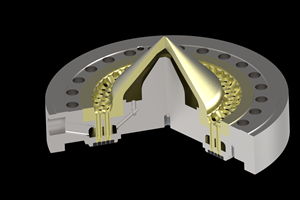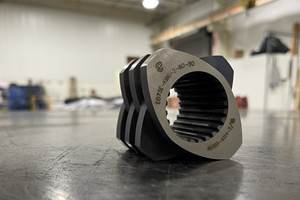Get Smarter on Extruder Sizes
Extrusion Know How
Processors tend to recommend a much larger extruder than what’s really necessary for the job and the capabilities of the downstream equipment.
Knowing that customer requirements change continuously and output improvements are always being pursued, operating people nowadays tend to recommend a much larger extruder than what’s really necessary for the job and the capabilities of the downstream equipment. While getting an oversized extruder provides “just-in-case” flexibility, it can also result in much higher daily operating costs. Let’s take a look at why.
Both AC and DC drives have a higher power usage per pound of output at low speeds. DC drives are even more expensive to operate than AC drives at low speeds because of their additional disadvantage of poor power factor at low speed. The larger extruder increases thermal losses to the environment because the latter are proportional to the heated surface area of the extruder. This can be useful in cold weather to heat the plant, but it is a major cost factor in warm weather, particularly if it requires use of air conditioning.
The electrical requirements for heat-up and temperature maintenance are also proportional to the extruder’s mass. Heat-up time can double from one extruder size to the next. Although not usually a major cost factor, larger extruders also require more floor space. More importantly, they also require larger-capacity utilities with higher expenses associated with installation and maintenance.
Another important cost factor is the extra time it takes to start up and change over a larger extruder. This extra time results in lost production and generation of larger amounts of scrap. Even routine changeovers requiring purging are more expensive, as much more purge material is required to change materials or colors.
Naturally the capital investment expense goes up with machine size, and that has to be amortized into the production cost. Moving up one extruder size roughly doubles the installed capital investment. At equivalent outputs, larger extruders have more residence time and have more material inside, increasing the likelihood of degradation as well as the amount of degraded polymer.
Simply put, extruder size needs to be considered in the daily economics of producing extruded products. For example, operating a 4.5-in. extruder at 1000 lb/hr and a 6-in. extruder at the same output can result in a 50-100% increase in total operating cost, depending on the particulars of the equipment, electrical cost, number of changeovers, and polymers being processed.
Deciding on the right extruder size is also important when deploying the extruders you already have in place. Many times, I have seen little or no thought going into the selection of the most economical extruder. Recently I saw thin-gauge, narrow PET sheet being run on a 6-in., 34:1 extruder with a 500-hp drive. The screw speed was 36 rpm with a maximum of 125 rpm. Sitting nearby was an older 4.5-in, 30:1 extruder with 200 hp that would have done fine. But the processor preferred the new line because it was easier to operate. Here the hourly operating cost was approximately twice what it could/should have been.
Picking the right size extruder is pretty much a function of the output at a reasonable screw speed. The proper L/D ratio depends on the requirements for mixing, venting, and pressure generation. Horsepower is a function of output and the polymer being processed and can be easily calculated. However, this can be a rather complex matrix of choices, and decisions should be left to experts.
My advice is to develop an hourly operating cost for each extrusion line and try to fit production to the least expensive line as a part of the scheduling procedure.
Related Content
How to Maintain Pelletizing Quality When Acid Attacks
Developments in the chemistry of polymers and additives have made corrosion a real problem in pelletizers. Here’s how to ward it off.
Read MoreUnderstanding 'Boundary Conditions' in Twin-Screw Compounding
In twin-screw compounding, the objective is generally to produce the highest quality product at the maximum strand. But sometimes there are operating parameters that prevent this objective from being realized.
Read MoreHow to Configure Your Twin-Screw Extruder for Mixing: Part 5
Understand the differences between distributive and dispersive mixing, and how you can promote one or the other in your screw design.
Read MoreSirmax Adapts Integrated Recycling Approach to US Supply Conditions
Integrating compounding and recycling to leverage untapped postindustrial recycling feedstocks.
Read MoreRead Next
See Recyclers Close the Loop on Trade Show Production Scrap at NPE2024
A collaboration between show organizer PLASTICS, recycler CPR and size reduction experts WEIMA and Conair recovered and recycled all production scrap at NPE2024.
Read MoreBeyond Prototypes: 8 Ways the Plastics Industry Is Using 3D Printing
Plastics processors are finding applications for 3D printing around the plant and across the supply chain. Here are 8 examples to look for at NPE2024.
Read More.jpg;width=70;height=70;mode=crop)











